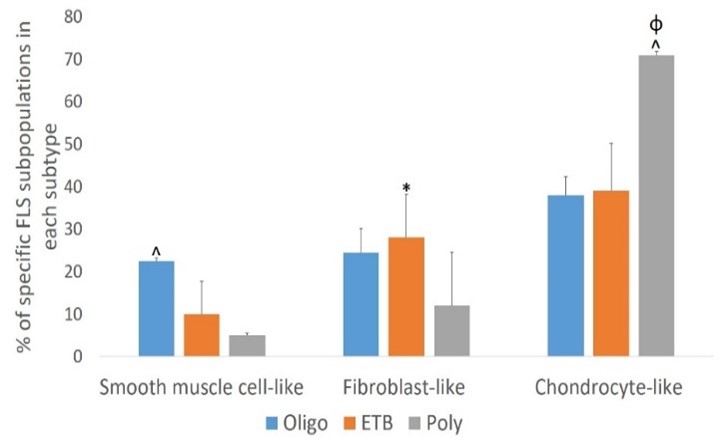Session Information
Session Type: Poster Session A
Session Time: 6:00PM-7:00PM
Background/Purpose: Juvenile idiopathic arthritis (JIA) is the most common rheumatic disease of childhood and carries a risk of permanent joint damage and disability [1]. In adult rheumatoid arthritis (RA), early aggressive treatment can lead to remission. This may also be true for JIA in children; however, treatment paradigms in JIA remain reactive rather than proactive due to lack of reliable methods to predict extension to a polyarticular course. Our objective was to validate cell subpopulations using flow cytometry to predict which patients have a high likelihood of extending.
Methods: JIA FLS cell lines from oligoarticular (oligo), extended-to-be (ETB), and polyarticular (poly) types were cultured. Flow cytometry was performed by Raybiotech, Inc. scRNA-seq was performed by Genewiz according to 10x Genomics Chromium protocols. SeuratR package was used for QC, analysis, and exploration of data.
Results: Fibroblast-like synoviocytes are heterogeneous. Cells from scRNA-seq were annotated using SingleR data package. Subpopulation percentages were calculated from cell counts (Figure 1). Smooth muscle cell-like cells (SMC) decreased in poly (p 0.05 in oligo v poly). Fibroblast-like cell (FLS) percentage was higher in ETB than oligo (p 0.05). Chondrocyte-like cells (CH) percentage increased in poly compared to oligo and ETB (p 0.05). We performed flow cytometry on normal cell lines to determine if traditional markers for CH, SMC, and FLS can distinguish these cell types from one another. These markers did not confidently isolate these cell types (Figure 2). As a result, we analyzed our scRNA-seq data for markers that could distinguish JIA subtypes via flow cytometry (CH – SMOC2, SOX9; FLS – IGFBP4, VCAN; SMC – CD309). These markers could not distinguish FLS from CH using flow. We revisited gene data from scRNA-seq. Seurat single analysis identified the top genes of each projected cell type for each subtype. Genes that contribute the most variation among cells within a JIA subtype are as follows: oligo – COL1A1, MT-ND1, TUBA1B, ACAN, and IFI27, ETB – MTRNR2LB, SERPINE1, TOP2A, MEG3, COL3A1, and VCAM, poly – ACP5, SPP1, TNFAIP6, IGFBP5, AKAP12, MFAP5, and S100A4 (Figure 3).
Conclusion: While flow cytometry has proven unable to distinguish between cell subpopulations within FLS cultures, these cell subpopulations have unique genetic fingerprints with transcript expression levels that can be used to distinguish JIA subtypes.
1. Manners, P.J. and C. Bower, Worldwide prevalence of juvenile arthritis why does it vary so much? The Journal of rheumatology, 2002. 29(7): p. 1520-1530.
The authors wish to acknowledge CARRA and the ongoing Arthritis Foundation financial support of CARRA.
 Figure 1. Percentage of FLS subpopulations in cultured FLS from patients with oligoarticular (Oligo), extended-to-be (ETB), and polyarticular (Poly) JIA. The percentage of smooth muscle-cell-like cells decreases in more severe subtypes of JIA; fibroblast-like cells significantly increased in ETB compared to Oligo; and chondrocyte-like cells increases in more severe subtypes of JIA. ^p < 0.0006 Oligo vs. Poly; *p=0.03 Oligo vs. ETB; p=0.0044 ETB vs. Poly.
Figure 1. Percentage of FLS subpopulations in cultured FLS from patients with oligoarticular (Oligo), extended-to-be (ETB), and polyarticular (Poly) JIA. The percentage of smooth muscle-cell-like cells decreases in more severe subtypes of JIA; fibroblast-like cells significantly increased in ETB compared to Oligo; and chondrocyte-like cells increases in more severe subtypes of JIA. ^p < 0.0006 Oligo vs. Poly; *p=0.03 Oligo vs. ETB; p=0.0044 ETB vs. Poly.
 Table 1. Traditional markers from literature to distinguish cell types. Expected outcomes based on literature (A). Actual outcomes based on flow cytometry (B).
Table 1. Traditional markers from literature to distinguish cell types. Expected outcomes based on literature (A). Actual outcomes based on flow cytometry (B).
 Figure 3. Genes that are the highest contributors to variation among subpopulations. Genes that contribute the most variation among cell subpopulations are as follows: oligo – COL1A1, MT-ND1, TUBA1B, ACAN, and IFI27, ETB – MTRNR2LB, SERPINE1, TOP2A, MEG3, COL3A1, and VCAM, poly – ACP5, SPP1, TNFAIP6, IGFBP5, AKAP12, MFAP5, and S100A4
Figure 3. Genes that are the highest contributors to variation among subpopulations. Genes that contribute the most variation among cell subpopulations are as follows: oligo – COL1A1, MT-ND1, TUBA1B, ACAN, and IFI27, ETB – MTRNR2LB, SERPINE1, TOP2A, MEG3, COL3A1, and VCAM, poly – ACP5, SPP1, TNFAIP6, IGFBP5, AKAP12, MFAP5, and S100A4
To cite this abstract in AMA style:
Simonds M, Sullivan K, Brescia A. Predicting Extension in Juvenile Idiopathic Arthritis [abstract]. Arthritis Rheumatol. 2023; 75 (suppl 4). https://acrabstracts.org/abstract/predicting-extension-in-juvenile-idiopathic-arthritis/. Accessed .« Back to 2023 Pediatric Rheumatology Symposium
ACR Meeting Abstracts - https://acrabstracts.org/abstract/predicting-extension-in-juvenile-idiopathic-arthritis/
